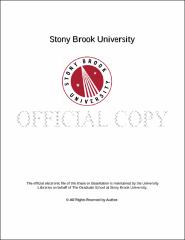| dc.identifier.uri | http://hdl.handle.net/11401/77402 | |
| dc.description.sponsorship | This work is sponsored by the Stony Brook University Graduate School in compliance with the requirements for completion of degree. | en_US |
| dc.format | Monograph | |
| dc.format.medium | Electronic Resource | en_US |
| dc.language.iso | en_US | |
| dc.publisher | The Graduate School, Stony Brook University: Stony Brook, NY. | |
| dc.type | Dissertation | |
| dcterms.abstract | To study adaptation to nutrient limitation and to understand the generation of adaptive diversity in evolving populations, we evolved Escherichia coli populations in twelve chemostats under three nutrient limiting regimes: four under nitrogen limitation, four under magnesium limitation and four in environments where the concentrations for both these nutrients are low. We traced the fitness trajectory of these populations over a period of ~400 generations. We also sequenced populations at two different time points to identify targets of selection and to investigate the mutation dynamics in these different nutrient-limiting environments. Our results show that populations evolving under nutrient limiting conditions have high levels of adaptive heterogeneity. We found 39 and 35 potential targets of selection in environments limited by nitrogen and magnesium respectively. We also found 21 potential targets of selection in environments where the concentrations of both these nutrients are low. Global gene regulators NtrBC were primary target of selection under nitrogen limiting conditions while genes involved in regulating membrane physiology were important targets of selection under magnesium limiting conditions. Our experiments also showed that the evolutionary dynamics of populations evolving in single nutrient limited environment is different to that of populations evolving in environments where concentrations of multiple nutrients are low; with different nutrients becoming potentially limiting for populations over their evolutionary trajectory in the latter. We also found a transient nature of adaptive mutations in these populations suggesting a complicated process of birth and death of lineages with adaptive mutations. We use this data to describe the fitness landscapes for populations evolving under nutrient limiting conditions. Overall this thesis increases our understanding of how populations adapt to nutrient limitation and highlights the intricate nature of adaptive mutation dynamics in these evolving populations. | |
| dcterms.available | 2017-09-20T16:52:38Z | |
| dcterms.contributor | Rest, Joshua | en_US |
| dcterms.contributor | Dykhuizen, Daniel E | en_US |
| dcterms.contributor | Baines, Stephen | en_US |
| dcterms.contributor | Gresham, David. | en_US |
| dcterms.creator | Warsi, Omar Mahmud | |
| dcterms.dateAccepted | 2017-09-20T16:52:38Z | |
| dcterms.dateSubmitted | 2017-09-20T16:52:38Z | |
| dcterms.description | Department of Ecology and Evolution. | en_US |
| dcterms.extent | 141 pg. | en_US |
| dcterms.format | Application/PDF | en_US |
| dcterms.format | Monograph | |
| dcterms.identifier | http://hdl.handle.net/11401/77402 | |
| dcterms.issued | 2014-12-01 | |
| dcterms.language | en_US | |
| dcterms.provenance | Made available in DSpace on 2017-09-20T16:52:38Z (GMT). No. of bitstreams: 1
Warsi_grad.sunysb_0771E_12087.pdf: 3800919 bytes, checksum: 1d893a955144d73df93d349688c5e257 (MD5)
Previous issue date: 1 | en |
| dcterms.publisher | The Graduate School, Stony Brook University: Stony Brook, NY. | |
| dcterms.subject | Ecology, Evolution, Genetics, Microbes | |
| dcterms.subject | Evolution & development | |
| dcterms.title | Adaptation and mutation dynamics in populations evolving under nutrient limiting conditions | |
| dcterms.type | Dissertation | |

